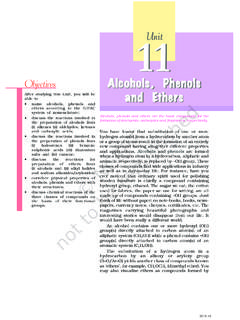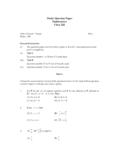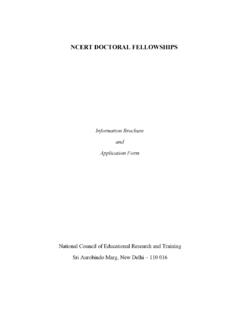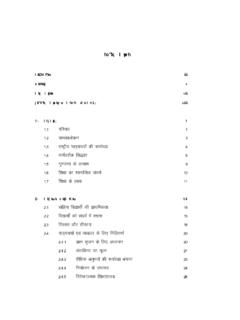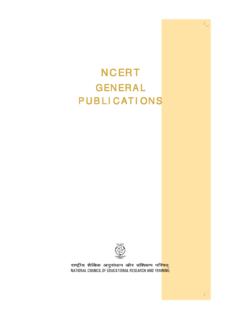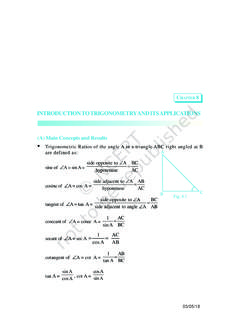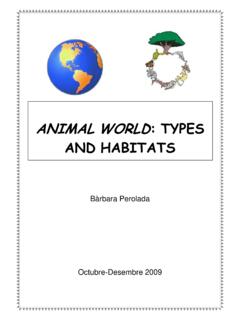Transcription of and Wild Life Natural Vegetation
1 6 Natural Vegetationand Wild LifeSalima was excited about the summer camp she wasattending. She had gone to visit Manali in HimachalPradesh along with her class mates. She recalled howsurprised she was to see the changes in the landformand Natural Vegetation as the bus climbed higher andhigher. The deep jungles of the foothills comprising saland teak slowly disappeared. She could see tall treeswith thin pointed leaves and cone shaped canopies onthe mountain slopes. She learnt that those were coniferoustrees. She noticed blooms of bright flowers on tall were the rhododendrons.
2 From Manali as she wastravelling up to Rohtang pass she saw that the land wascovered with short grass and snow in some Salima sobservations, we surmisethat there is a closerelationship betweenheight of land and thecharacter of the change in height,the climate changes andthat changes naturalvegetation. The growth ofvegetation depends ontemperature and moisture. It also depends on factorslike slope and thickness of type and thickness of Natural Vegetation variesfrom place to place because of the variation in these Vegetation is generally classified in to threebroad categories as follows:(a)Forests: Which grow where temperature and rainfallare plentiful to support a tree cover.
3 Depending uponthese factors, dense and open forests are s doNow can you tell whySalima saw changesin the naturalvegetation as sheclimbed higher andhigher? What types ofvegetations did shesee in the Himalayasstarting with thefoothills and going tothe higher altitudes?Let s do Like Salima, whenyou go to visit anynew place, noticethe type of naturalvegetation occurringthere and try tothink of factorsresponsible for thegrowth of suchvegetation in thathabitat. Note down if anyhuman interferencehas taken place inthat area in termsof deforestation,grazing, cultivationof cash crops,constructionalactivities : Rhododendron2021-2240 OUR ENVIRONMENT(b)Grasslands: Which grow in the region of moderate rain.
4 (c)Shrubs: Thorny shrurbs and scrubs grow in the dryregion (Fig. ).Salima was sharing her experience of Himalayan tripwith her father. Her father visited various places in theworld. He told Salima about his observations of the varietyof Vegetation in different parts of different about coniferous forests in the sub polarregions, thorny bushes in the deserts, thick tropicalhardwood forest in the humid regions and many realised the Himalayas have almost all variety ofvegetation which one can see while moving from theequator to the polar changes in the type of Natural Vegetation occurmainly because of the changes of climatic condition.
5 Letus get to know the different types of Natural vegetationof the world with their characteristic features and wildlifeinhabiting Evergreen ForestsThese forests are also called tropical rainforests(Fig. ). These thick forests occur in the regions nearthe equator and close to the tropics. These regions arehot and receive heavy rainfall throughout the year. Asthere is no particular dry season, the trees do not shedtheir leaves altogether. This is the reason they arecalled evergreen. The thick canopies of the closelyspaced trees do not allow the sunlight to penetrateinside the forest even in the day time.
6 Hardwood treeslike rosewood, ebony, mahogany are common you know?The tropical evergreenforest in Brazil is soenormous that it islike the lungs of theearth: Can you tellwhy?Do you know?Anaconda, one of theworld s largest snakesis found in thetropical rainforest. Itcan kill and eat alarge animal such asa : A Tropical Evergreen ForestFig. : Thorny shrubs2021-22 Natural Vegetation AND WILD LIFE41 Tropical Deciduous ForestsTr opical deciduous are the monsoon forests found inthe large part of India,northern Australia and in centralAmerica (Fig. ).These regions experience seasonalchanges.
7 Trees shed their leaves in the dry season toconserve water. The hardwood trees found in theseforests are sal, teak, neem and shisham. Hardwood treesare extremely useful for making furniture, transportand constructional materials. Tigers, lions, elephants,langoors and monkeys are the common animals of theseregions (Fig. , and ).Fig. : A Tropical Deciduous ForestFig. : A TigerFig. : A Golden LangoorLet s do Where in India dotropical evergreenand tropicaldeciduous forestsoccur? Name thestates. Which type of forestdominates mostpart of India?Fig. : A Temperate Evergreen ForestTemperate Evergreen ForestsThe temperate evergreen forests are located in the mid-latitudinal coastal region (Fig.)
8 They are commonlyfound along the eastern margin of the continents, , Insouth east USA, South China and in South East comprise both hard and soft wood trees like oak,pine, eucalyptus, : Elephants2021-2242 OUR ENVIRONMENTT emperate Deciduous ForestsAs we go towards higher latitudes, there are moretemperate deciduous forests (Fig. ). These are foundin the north eastern part of USA, China, New Zealand,Chile and also found in the coastal regions of WesternEurope. They shed their leaves in the dry season. Thecommon trees are oak, ash, beech, etc. Deer, foxes , wolvesare the animals commonly found.
9 Birds like pheasants,monals are also found here (Fig. and ).Do you know? Mediterranean treesadapt themselves todry summers withthe help of theirthick barks and waxcoated leaves whichhelp them reducetranspiration. Mediterraneanregions are knownas Orchards of theworld for their : A vineyard in the Mediterranean RegionFig. : A PheasantFig. : A MonalFig. : A Temperate Deciduous ForestMediterranean VegetationYou have learnt that most of the east and north eastmargins of the continents are covered by temperateevergreen and deciduous trees. The west and south westmargins of the continents are different.
10 They haveMediterranean Vegetation (Fig. ). It is mostly foundin the areas around the Mediterranean sea in Europe,Africa and Asia, hence the name. This kind of vegetationis also found outside the actual Mediterranean region inCalifornia in the USA, south west Africa, south western2021-22 Natural Vegetation AND WILD LIFE43 Let s doSouth America and South west Australia. These regionsare marked for hot dry summers and mild rainy fruits such as oranges, figs, olives and grapes arecommonly cultivated here because people have removedthe Natural Vegetation in order to cultivate what theywant to.
